Today, EYE Filmmuseum in Amsterdam presents the French silent film La Chèvre aux pieds d'or/The Goat with the Golden Feet (Jacques Robert, 1925), vaguely inspired by the biography of Mata Hari. The film is shown within the framework of the new exhibition Mata Hari - The Myth and the Maiden at Fries Museum in Leeuwarden, and introduced by film historian and EFSP co-editor Ivo Blom, who collaborated on the exhibition. Male lead of the film is Romuald Joubé (1876-1949). He was a French silent film actor, who became famous for his part in Abel Gance’s J’accuse (1918). He also acted in various naturalistic features by André Antoine.

French postcard by Editions Filma, no. 50. Photo: Pathé.
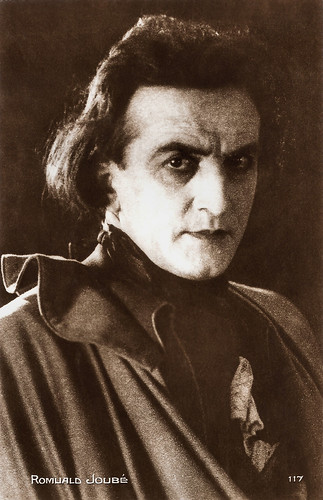
French postcard by Editions Cinémagazine, no. 117.
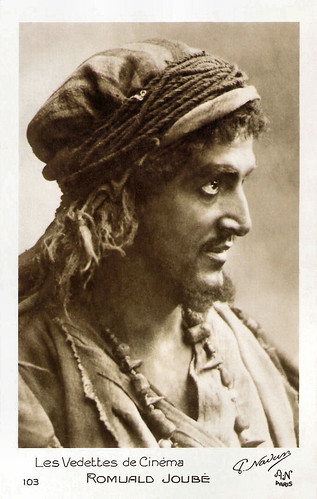
French postcard in the series Les Vedettes de Cinéma by A.N., Paris, no 103. Photo: P. Nadar.
Romuald Joubé, originally Romuald Charles Eugène Goudens Jean Sylve Joubé was born in Mazères, France in 1876.
Around 1900, Joubé already acted on stage with the troupe of the Nouveau-Théàtre of Paris, directed by Lugné-Poë. Around 1909 he started at the Théàtre de l’Odéon with plays directed by André Antoine, the master of Naturalism in French theatre.
In 1910 he debuted in the cinema in the Film d’art productions. He played in various shorts, often directed by Henri Desfontaines. These included Polyeucte (Camille de Morlhon, 1910), Philémon et Baucis (Georges Denola, 1911) as Philemon, Milton (Henri Desfontaines, 1911) with Constant Rémy, La Mégère apprivoisée/The Taming Of The Shrew (Henri Desfontaines, 1911). He played the title roles in Le Colonel Chabert (Henri Pouctal, André Calmettes, 1911) and Brittanicus (Camille de Morlhon, 1912)
Other Film d'art films were Serge Panine (Henri Pouctal, 1913), Le Baiser supreme/The Kiss supreme (Edmond Floury, 1913) opposite Gabriel Signoret, Les Deux gosses/The Two Kids (Albert Capellani, 1914) with Paul Capellani, Amour sacré/Holy Love (Dominique Bernard-Deschamps, 1915), and Le Dernier rêve/The Last Dream (Henri Desfontaines, 1916).
In 1917, Joubé started to act in various features by André Antoine, who transferred his Naturalism onto cinema as well: the Alexandre Dumas père adaptation Les Frères corses/The Corsican Brothers (André Antoine, 1917) with Henry Krauss, the François Coppée adaptation Le Coupable/The Culprit (André Antoine, 1917) with Sylvie, and the fishermen drama Les Travailleurs de la mer/The Workers of the sea (André Antoine, 1918), based on Victor Hugo.
By now Joubé was playing both leading and supporting parts. In 1918-1919, Joubé played one of his most famous roles in the pacifist, First World War drama J’Accuse/I Accuse by Abel Gance, which was released in France in April 1919, so a few months after the Armistice.
Joubé plays Jean Diaz, a poet who is in love with Edith (Marise Dauvray), the wife of François Laurin (Séverin-Mars). The two men meet in the trenches and experience the horrors of the war. Laurin saves Diaz’ life and sacrifices himself for the benefit of the other two. Edith is raped by a German, raising the fruit of this encounter despite hostility. Maddened, Diaz returns from the trenches, despises his art and asks the village inhabitants: was it worthwhile, all the sacrifices, while the ghosts of the killed soldiers march up to them.
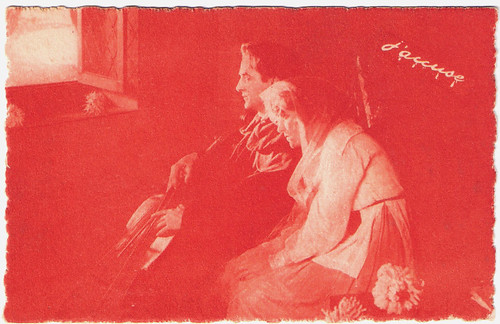
French postcard by Sadag de France, Paris, no. 109. Publicity still for J'Accuse (Abel Gance, 1919) with Edith (Marise Dauvray), Jean Diaz (Romuald Joubé).
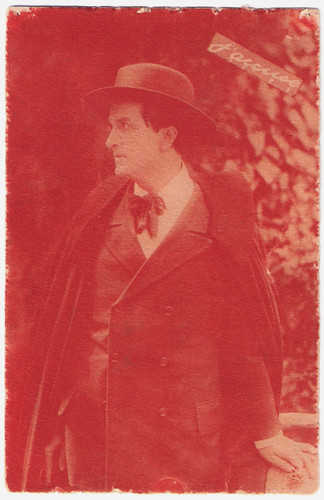
French postcard by Sadag de France, Paris. Publicity still for J'Accuse (Abel Gance, 1919).
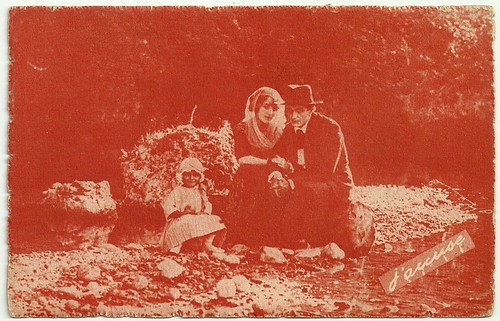
French postcard by Sadag de France, Paris, no. 109. Publicity still for J'Accuse (Abel Gance, 1919) with Edith (Marise Dauvray), Jean Diaz (Romuald Joubé) and little Angele (Angèle Guys), towards the end of the film.
With J’Accuse, Romuald Joubé established his career, though he didn’t continue to act with Gance. Instead he performed opposite Emmy Lynn in La faute d’Odette Marchal/Odette Marchal's fault (Henri Roussel, 1920), opposite Huguette Duflos in Mademoiselle de La Seiglière (André Antoine, 1921), opposite Sylviane Dumont in Fleur de neige/Snow Flower (Paul Barlatier, 1921) and he played the title role in the Jules Verne adaptation Mathias Sandorf (Henri Fescourt, 1921).
Subsequently he appeared opposite Pierre Fresnay in Le Diamant noir/The Black Diamond (André Hugon, 1922) and opposite Nathalie Lissenko in La Fille sauvage (Henri Étievant, 1922).
From 1923 Joubé alternated film with the stage. In the theatre he played e.g. the title role in Peer Gynt in 1924. Still he had big film roles as Andréa in Rouletabille chez les bohémiens/Rouletabille and the Bohemians (Henri Fescourt, 1923) with Gabriel de Gravone, as the title character in the historical adventure film Mandrin (Henri Fescourt, 1924) costarring Jacqueline Blanc, and as chevalier Robert Cottereau in the lavish period piece Le Miracle des loups/Miracle of the Wolves (Raymond Bernard, 1924).
In 1925 Joubé not only acted opposite Lilian Constantini in La Chèvre aux pieds d'or/The Goat with the golden feet (Jacques Robert, 1925), but he also went to Italy to act in several historical films by Giulio Antamoro: La Fanciulla di Pompei/The young girl of Pompeii (Giulio Antamoro, 1925) with Leda Gys, La Cieca di Sorrento/The Blind Girl of Sorrento (Giulio Antamoro, 1925) and Frate Francesco/The Passion of St. Francis (Giulio Antamoro, 1927).
Probably Joubé’s last silent film was the Henri Kistemaeckers adaptation Princesse Masha/Princess Masha (1927, René Leprince). The film is about an illegitimate Russian princess, raised by revolutionary intellectuals, who flees to Paris during the revolution and falls in love with a Frenchman (Joubé), but marries a cruel Russian ambassador to save her foster father (in vain). Returned to Russia during the war, she tries to flee again, with her French lover, and sacrifices herself in the end for his honour. The film starred Claudia Victrix, a French singer who debuted in this film. Costars were Jean Toulout and Andrée Brabant.
When sound cinema became the standard in France, Joubé didn’t act in films for years, though he was visible in a sonorised version of Le Miracle des loups (1930). In 1929 he acted in various stage plays in Canada, together with Germaine Rouer. In the same year he also acted in Histoires de France, the play by Sacha Guitry that opened the new Théàtre Pigalle in Paris in 1929.
In 1937 he returned to the film set with a small part as Jean Diaz in Abel Gance’s own remake of J’accuse (Abel Gance, 1938), while the larger share of the character was played by Victor Francen. That year he also played Clouet in Sacha Guitry’s period piece Les Perles de la couronne (Sacha Guitry, 1937).
Joubé played his last roles in film and on stage during the Second World War. On stage he played in the Georges Simenon adaptation Le Pavillon d'Asnières (1943), while on the set he performed in a.o. Chant de l'exilé/Song of Exile (André Hugo, 1943) starring Tino Rossi.
Romuald Joubé died in 1949 in Gisors, France.
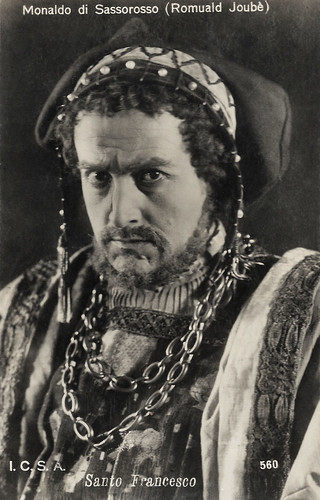
Italian postcard by ICSA, no. 560. Photo: publicity still for Frate Francesco (Giulio Antamoro, 1927) with Romuald Joubé as Monaldo di Sassorosso.
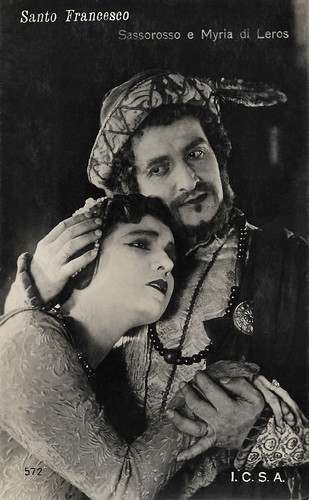
Italian postcard by ICSA, no. 572. Photo: publicity still for Frate Francesco (Giulio Antamoro, 1927) with Monaldo di Sassorosso (Romuald Joubé) and Myria di Leros (Donatella Gemmò).
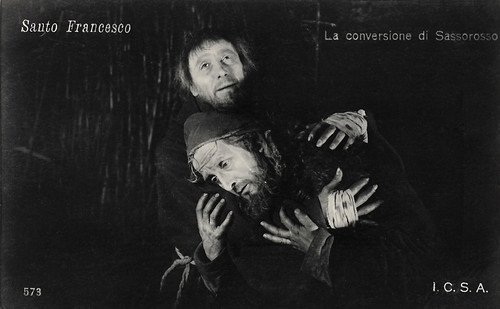
Italian postcard by ICSA, no. 573. Photo: publicity still for Frate Francesco (Giulio Antamoro, 1927). Caption: 'The conversion of Sassorosso.' Visible are Alberto Pasquali as St. Francis and Romuald Joubé as Sassorosso.

French postcard by Cinémagazine-Edition, Paris, no. 361.

French postcard in the series Les Vedettes de Cinéma by A.N., Paris, no. 76. Photo: G.L. Manuel Frères.
Sources: CinéRessources, Films de France, Wikipedia (French) and IMDb.

French postcard by Editions Filma, no. 50. Photo: Pathé.

French postcard by Editions Cinémagazine, no. 117.

French postcard in the series Les Vedettes de Cinéma by A.N., Paris, no 103. Photo: P. Nadar.
The Horrors of the War
Romuald Joubé, originally Romuald Charles Eugène Goudens Jean Sylve Joubé was born in Mazères, France in 1876.
Around 1900, Joubé already acted on stage with the troupe of the Nouveau-Théàtre of Paris, directed by Lugné-Poë. Around 1909 he started at the Théàtre de l’Odéon with plays directed by André Antoine, the master of Naturalism in French theatre.
In 1910 he debuted in the cinema in the Film d’art productions. He played in various shorts, often directed by Henri Desfontaines. These included Polyeucte (Camille de Morlhon, 1910), Philémon et Baucis (Georges Denola, 1911) as Philemon, Milton (Henri Desfontaines, 1911) with Constant Rémy, La Mégère apprivoisée/The Taming Of The Shrew (Henri Desfontaines, 1911). He played the title roles in Le Colonel Chabert (Henri Pouctal, André Calmettes, 1911) and Brittanicus (Camille de Morlhon, 1912)
Other Film d'art films were Serge Panine (Henri Pouctal, 1913), Le Baiser supreme/The Kiss supreme (Edmond Floury, 1913) opposite Gabriel Signoret, Les Deux gosses/The Two Kids (Albert Capellani, 1914) with Paul Capellani, Amour sacré/Holy Love (Dominique Bernard-Deschamps, 1915), and Le Dernier rêve/The Last Dream (Henri Desfontaines, 1916).
In 1917, Joubé started to act in various features by André Antoine, who transferred his Naturalism onto cinema as well: the Alexandre Dumas père adaptation Les Frères corses/The Corsican Brothers (André Antoine, 1917) with Henry Krauss, the François Coppée adaptation Le Coupable/The Culprit (André Antoine, 1917) with Sylvie, and the fishermen drama Les Travailleurs de la mer/The Workers of the sea (André Antoine, 1918), based on Victor Hugo.
By now Joubé was playing both leading and supporting parts. In 1918-1919, Joubé played one of his most famous roles in the pacifist, First World War drama J’Accuse/I Accuse by Abel Gance, which was released in France in April 1919, so a few months after the Armistice.
Joubé plays Jean Diaz, a poet who is in love with Edith (Marise Dauvray), the wife of François Laurin (Séverin-Mars). The two men meet in the trenches and experience the horrors of the war. Laurin saves Diaz’ life and sacrifices himself for the benefit of the other two. Edith is raped by a German, raising the fruit of this encounter despite hostility. Maddened, Diaz returns from the trenches, despises his art and asks the village inhabitants: was it worthwhile, all the sacrifices, while the ghosts of the killed soldiers march up to them.

French postcard by Sadag de France, Paris, no. 109. Publicity still for J'Accuse (Abel Gance, 1919) with Edith (Marise Dauvray), Jean Diaz (Romuald Joubé).

French postcard by Sadag de France, Paris. Publicity still for J'Accuse (Abel Gance, 1919).

French postcard by Sadag de France, Paris, no. 109. Publicity still for J'Accuse (Abel Gance, 1919) with Edith (Marise Dauvray), Jean Diaz (Romuald Joubé) and little Angele (Angèle Guys), towards the end of the film.
Lavish Period Piece
With J’Accuse, Romuald Joubé established his career, though he didn’t continue to act with Gance. Instead he performed opposite Emmy Lynn in La faute d’Odette Marchal/Odette Marchal's fault (Henri Roussel, 1920), opposite Huguette Duflos in Mademoiselle de La Seiglière (André Antoine, 1921), opposite Sylviane Dumont in Fleur de neige/Snow Flower (Paul Barlatier, 1921) and he played the title role in the Jules Verne adaptation Mathias Sandorf (Henri Fescourt, 1921).
Subsequently he appeared opposite Pierre Fresnay in Le Diamant noir/The Black Diamond (André Hugon, 1922) and opposite Nathalie Lissenko in La Fille sauvage (Henri Étievant, 1922).
From 1923 Joubé alternated film with the stage. In the theatre he played e.g. the title role in Peer Gynt in 1924. Still he had big film roles as Andréa in Rouletabille chez les bohémiens/Rouletabille and the Bohemians (Henri Fescourt, 1923) with Gabriel de Gravone, as the title character in the historical adventure film Mandrin (Henri Fescourt, 1924) costarring Jacqueline Blanc, and as chevalier Robert Cottereau in the lavish period piece Le Miracle des loups/Miracle of the Wolves (Raymond Bernard, 1924).
In 1925 Joubé not only acted opposite Lilian Constantini in La Chèvre aux pieds d'or/The Goat with the golden feet (Jacques Robert, 1925), but he also went to Italy to act in several historical films by Giulio Antamoro: La Fanciulla di Pompei/The young girl of Pompeii (Giulio Antamoro, 1925) with Leda Gys, La Cieca di Sorrento/The Blind Girl of Sorrento (Giulio Antamoro, 1925) and Frate Francesco/The Passion of St. Francis (Giulio Antamoro, 1927).
Probably Joubé’s last silent film was the Henri Kistemaeckers adaptation Princesse Masha/Princess Masha (1927, René Leprince). The film is about an illegitimate Russian princess, raised by revolutionary intellectuals, who flees to Paris during the revolution and falls in love with a Frenchman (Joubé), but marries a cruel Russian ambassador to save her foster father (in vain). Returned to Russia during the war, she tries to flee again, with her French lover, and sacrifices herself in the end for his honour. The film starred Claudia Victrix, a French singer who debuted in this film. Costars were Jean Toulout and Andrée Brabant.
When sound cinema became the standard in France, Joubé didn’t act in films for years, though he was visible in a sonorised version of Le Miracle des loups (1930). In 1929 he acted in various stage plays in Canada, together with Germaine Rouer. In the same year he also acted in Histoires de France, the play by Sacha Guitry that opened the new Théàtre Pigalle in Paris in 1929.
In 1937 he returned to the film set with a small part as Jean Diaz in Abel Gance’s own remake of J’accuse (Abel Gance, 1938), while the larger share of the character was played by Victor Francen. That year he also played Clouet in Sacha Guitry’s period piece Les Perles de la couronne (Sacha Guitry, 1937).
Joubé played his last roles in film and on stage during the Second World War. On stage he played in the Georges Simenon adaptation Le Pavillon d'Asnières (1943), while on the set he performed in a.o. Chant de l'exilé/Song of Exile (André Hugo, 1943) starring Tino Rossi.
Romuald Joubé died in 1949 in Gisors, France.

Italian postcard by ICSA, no. 560. Photo: publicity still for Frate Francesco (Giulio Antamoro, 1927) with Romuald Joubé as Monaldo di Sassorosso.

Italian postcard by ICSA, no. 572. Photo: publicity still for Frate Francesco (Giulio Antamoro, 1927) with Monaldo di Sassorosso (Romuald Joubé) and Myria di Leros (Donatella Gemmò).

Italian postcard by ICSA, no. 573. Photo: publicity still for Frate Francesco (Giulio Antamoro, 1927). Caption: 'The conversion of Sassorosso.' Visible are Alberto Pasquali as St. Francis and Romuald Joubé as Sassorosso.

French postcard by Cinémagazine-Edition, Paris, no. 361.

French postcard in the series Les Vedettes de Cinéma by A.N., Paris, no. 76. Photo: G.L. Manuel Frères.
Sources: CinéRessources, Films de France, Wikipedia (French) and IMDb.
No comments:
Post a Comment